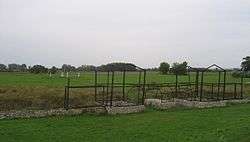Iža
Iža (Hungarian: Izsa, Hungarian pronunciation:[ˈiʒɒ]) is a village in south-western Slovakia.
Iža Izsa | |
|---|---|
Village | |
Catholic church in Iža | |
 Iža Location of Iža in Slovakia | |
| Coordinates: 47°45′N 18°14′E | |
| Country | Slovakia |
| Region | Nitra |
| District | Komárno |
| First mentioned | c. 150 |
| Area | |
| • Total | 28.02 km2 (10.82 sq mi) |
| Elevation | 111 m (364 ft) |
| Population (2004-12-31) | |
| • Total | 1,632 |
| • Density | 58/km2 (150/sq mi) |
| Postal code | 946 39 |
| Area code(s) | +421-35 |
| Car plate | KN |
Geography
The village lies at an altitude of 111 metres (364 ft) and covers an area of 28.073 km2 (10.839 sq mi). It is situated in the Komárno District of Slovakia's Nitra Region, very close to the town of Komárno.
History

The biggest Roman castellum in present-day Slovakia was located in Celemantia, an ancient settlement discovered on the territory of Iža. Celemantia was already mentioned by Claudius Ptolemaios in the 2nd century CE and it was abandoned in around 400 CE. The modern village of Iža was first mentioned in 1268.
Kelemantia was probably a bridgehead for the larger fortress of Brigetio, across the river near Komárom. But it was still fairly big, at 172 metres (564 ft) square. The excavated and partly reconstructed fort, which is accessible via a rough lane from Iža, was the second to be built on the site. It contained barracks, stable blocks and a bathhouse and was surrounded by a stone wall two metres (6 ft 7 in) thick and up to five metres (16 ft) high. Parts of these structures are now visible and described by information boards in four languages, including English.
The first fort on the site, whose foundations have been partly surveyed, was an earth and timber construction. It is believed to have been destroyed by barbarian attacks less than five years after it was built. Evidence of temporary encampments nearby - presumably built to house the large expeditionary force despatched by Rome to wallop the natives in turn - were revealed by an aerial survey in 1990.
In the 9th century, the territory of Iža became part of the Kingdom of Hungary. After the Austro-Hungarian army disintegrated in November 1918, Czechoslovak troops occupied the area, later acknowledged internationally by the Treaty of Trianon. Between 1938 and 1945 Iža once more became part of Miklós Horthy's Hungary through the First Vienna Award. From 1945 until the Velvet Divorce, it was part of Czechoslovakia. Since then it has been part of Slovakia.
Demographics
The village has a population of about 1,630 people. According to the 2001 census, the ethnic makeup was about 73% Hungarian, 25% Slovak, 1% Romany and 1% Czech.
Facilities
The village has a public library, a gym and a football pitch. Recently a new museum was opened in the village, which focuses specifically on the history of the Danube Lands
Genealogical resources
The records for genealogical research are available at the state archive "Statny Archiv in Nitra, Slovakia"
- Roman Catholic church records (births/marriages/deaths): 1722-1901 (parish A)
- Lutheran church records (births/marriages/deaths): 1783-1908 (parish B)
- Reformated church records (births/marriages/deaths): 1827-1895 (parish B)